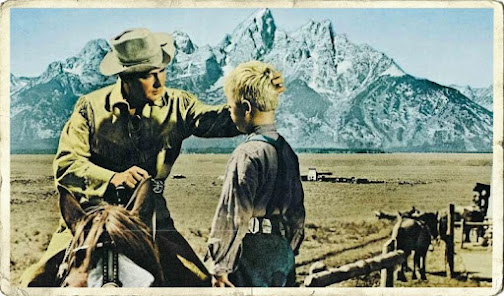Shane (1953)
Do you remember Dick Tracy? Do you remember Shane?
This is a line from ‘The Pros and Cons of Hitch-Hiking’, a song by Roger Waters, of Pink Floyd fame. To Waters, and many others, Shane is a dear childhood memory, to be cherished a life long. Shane tells the story of a boy’s adoration for a mysterious stranger who comes to the aid of his family, the Starrets, small farmers who have settled in a valley, way out West. They’re menaced by a rancher called Ryker, who wants to chase the newcomers. Ryker tries to break the farmers’ resistance by hiring a professional killer, Wilson, who sets an example by provoking an older man to a ‘fair’ duel. Stimulated by Shane, Starret organizes the farmers in their struggle for survival, but it’s of course Shane who faces Wilson in a final duel.
Shane is idolized by the boy Joey, who doesn’t understand what effect the stranger has on his immediate surroundings. When Shane rides off into the sunset, Joey runs after him, shouting his name, begging him to stay. He seems to realize that his mother loves the stranger, but not what the consequences of her affections are. Shane was based on a novel by Jack Schaefer. The novel works marvelously, thanks to the literal trick to make us readers understand the events better than the person telling them. It’s a first-person narrative, told by the boy Joey. We see the events through his eyes, but read different things into them. In the novel Shane and his opponent Wilson, the gunslinger hired by Ryker, are both menacing and mysterious persons. We understand much better than Joey that Shane's past must have been brutal and that he is a violent man too. Shane and Wilson are almost interchangeable characters: they have the same ability and readiness to kill if necessary. What makes Shane ‘good’ and Wilson ‘bad’, is Shane’s decision to side with the weaker party, the farmers.
In the film things are very different: instead of dark and menacing, Shane is all buckskin and goldilocks. And although Alan Ladd turns in a decent performance, some have suggested that Montgomery Clift, director Stevens first choice for the part, would have been a better Shane. Still there are moments that a glimpse can be spotted from the complex character suggested by the original story. There's a frightening scene with Shane reaching for his gun and turning around when he hears the sound of someone loading a gun behind him ... only to discover that it was the boy … And then there's this beautiful scene with Shane and Wilson silently examining each other, judging each other’s skills…
The story of Shane alludes to a specific historical background, the Johnson County War of 1892, in which the big ranchers, still believing in free grazing, tried to chase the fast growing number of small farmers limiting their possibilities. It’s often seen as a pivotal moment in American history, marking the transition from an anarchic state to a democracy in the making. The film never tries to be a history lesson but still director Stevens manages to evoke some of the horror and fear this violent conflict must have provoked among the small farmers, who were constantly under the threat of being killed if they didn’t move to somewhere else. Fistfights really seem painful and bloody events here, and Elisha Cook’s backward jump when he’s hit by Wilson’s bullet, was a very daring shot at realism, considering the time of making. Actually, Shane is quite violent for a fifties western and the action scenes – two elaborated fistfights and the final shoot-out – are among the best ever filmed.
I haven't seen Shane as a kid and that might be the reason that it has never been one of my special favorites. But there's no denying that it's a wonderful achievement, beautifully filmed and masterfully told. It was also very influential. With Alan Ladd as the proverbial guardian angel and Jack Palance as the evil incarnate, Shane became the blueprint for numerous westerns about the lone gunman coming to the aid of defenceless people. Ladd’s buckskin and Palance’s black gloves (and sadistic smile) became recurring elements within the genre. The mud covered streets of the little western town, and Loyal Griggs breathtakingly beautiful (and Oscar winning) cinematography of the Wyoming landscape, were equally important for the way the genre would look like in the future as John Ford’s glorification of Monument Valley. And once you’ve heard his name echoing through the valley, you’ll never forget the name of
“Shane!…”Dir: George Stevens - Cast: Alan Ladd, Jack Palance, Van Heflin, Brandon DeWilde, Jean Arthur, Ben Johnson, Edgar Buchanan, Emile Meyer, Elisha Cook Jr., Douglas Spencer









Comments
Post a Comment